Key Insights
- Despite the market headwinds in Q4, BNB Chain continued with an aggressive strategy to deploy financial and human capital across its ecosystem.
- Due to ecosystem developments, average daily active addresses and transactions bucked a downward trend and grew by 30% and 0.2%, respectively.
- BNB Chain’s growth strategy was at the core of network activity, including the MVB V Program, BNB Builder Grants, and the Growth Incentive Program.
- Staking and decentralization of the network improved. Due to network upgrades, the average engaged stake and Nakamoto coefficient grew steadily over the last year.
- An exploit on the BNB Smart Chain Token Hub brought the network to a halt. Thanks to the nature of the attack and the quick community response, no user funds were affected.
- Looking ahead, the approach to success will include upgrading network functionality (zkBNB), furthering decentralization (BEP-131), and implementing growth strategies (MVB VI).
Primer on BNB Chain
BNB Chain is a public, open-source blockchain that aims to deliver scalable smart contract support for decentralized applications. It seeks to accomplish this with a modular design and scaling solutions. The BNB Chain consists of a multichain framework — the BNB Smart Chain, Beacon Chain, BNB Sidechain, and BNB ZkRollup.
The Beacon Chain is the dedicated layer used for governance (staking and voting), and the BNB Smart Chain is the dedicated layer for Ethereum Virtual Machine (EVM) consensus and execution. The BNB Smart Chain is based on a Proof-of-Staked-Authority (PoSA) mechanism and is powered by a growing network of active validators. The BNB Sidechain framework is a recent development effort designed to create BNB Smart Chain-compatible sidechains. Plans also include the launch of ZK-rollups for high-performance scaling, allowing sidechains to customize solutions.
Key Metrics
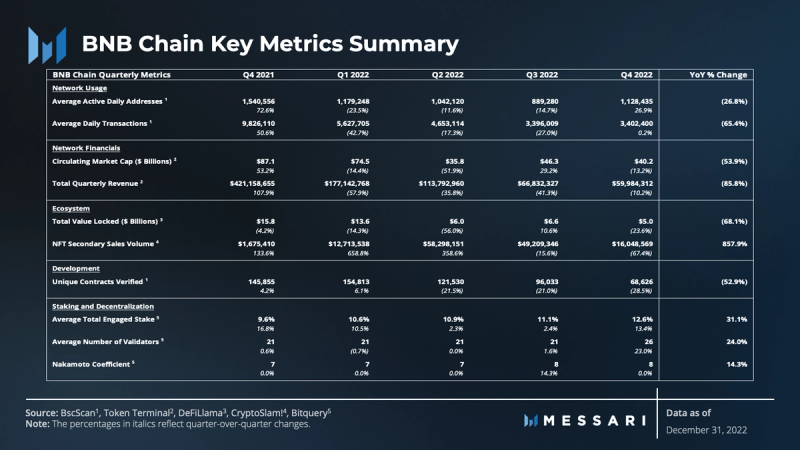
The Fourth Quarter Narrative
It was a rollercoaster of a year for the crypto industry. Macroeconomic forces sparked a bear market in January. The bear was perpetuated by the collapse of LUNA and UST in the spring. Finally, the failure of FTX and the contagion that followed brought the market to its knees. Despite the FTX drama and unfavorable price action, Q4 reflected that BNB Chain’s network and ecosystem continue to grow and remain competitive.
As the year rounded out, BNB Chain’s mission toward adoption remained intact. It boasted several network upgrades, integrations with partners like OpenSea, and the execution of an aggressive growth strategy to expand its ecosystem across DeFi, NFTs, GameFi, and beyond. Community building efforts also noticeably ramped up heading into 2023.
While BNB Chain experienced success in its technical upgrades and aggressive growth strategies, Q4 did present an adverse outcome stemming from technical challenges. The exploit related to the BSC Token Hub was isolated and unique, and BNB Chain users, its protocol, and cryptography were not affected.
As a follow-up to the State of BNB Chain Q3 2022 report, this report will dive into the quantitative performance over 2022 and Q4 and the qualitative evidence that BNB Chain is continuing to progress through adverse market conditions and usher in catalysts for growth.
Subsequent events will be covered in the State of BNB Chain Q1 2023 report.
Performance Analysis
Network and Financial Overview
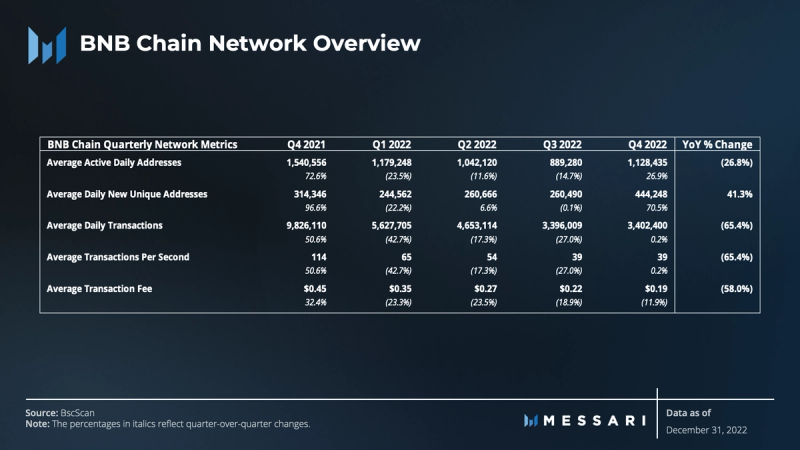
Despite the carnage unleashed by the implosion of FTX, BNB Chain’s user activity, measured by average daily active addresses, new unique addresses, and daily transactions, was up quarter-over-quarter (QoQ).
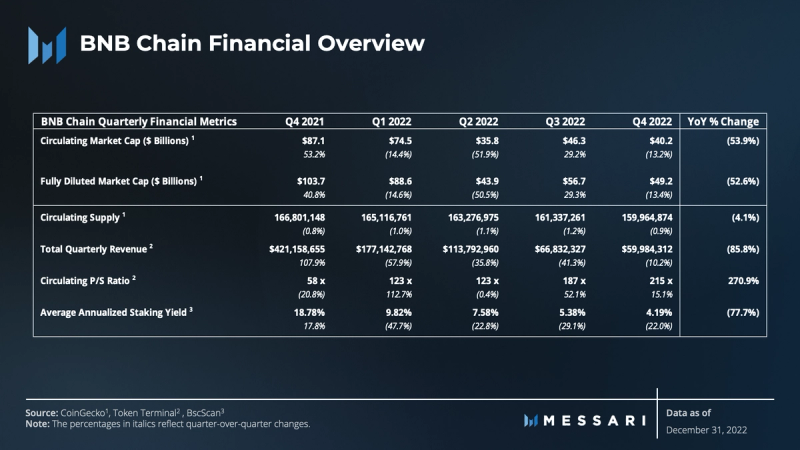
Despite greater user activity, financial performance was down. Average transaction fees decreased, which contributed to less revenue generation, and market cap (i.e., network value) followed suit, declining by 13.2%.
The circulating supply of BNB continued to decline due to the BNB token-burning mechanism. By December 31, over 40 million BNB had been burned since the burn program began in 2017.
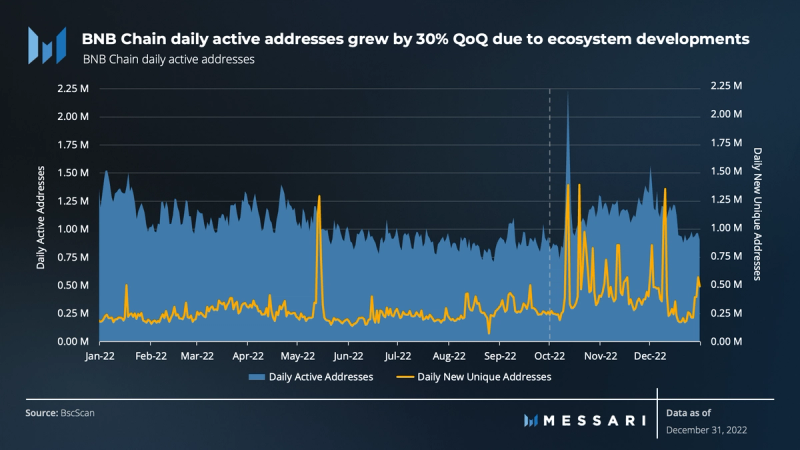
As highlighted in the Q3 report, the downward trend of active addresses was followed by an inflection point at the end of August 2022, while simultaneously outpacing longer-term averages. This was an early sign that a foundation user base was forming.
The presence of a foundational user base became even more apparent as average daily active addresses reversed course and grew by ~30% QoQ. Several ecosystem developments over the quarter sparked growth in both average daily addresses and new unique addresses.
Hooked Protocol witnessed accelerated adoption in early October, as new users began interacting with its smart contracts. A surge of DeFi activity on Venus Protocol and NFT activity on OpenSea occurred between November and early December. More details on these protocols and developments are provided later in this report.
Further, while the bear market put downward pressure on average active addresses year-over-year (-26.8% YoY), average daily new unique addresses grew by 41.3% YoY.
Nonetheless, BNB Chain’s apparent foundational user base grew QoQ, and new users were ushered in due to ecosystem expansion across DeSoc, DeFi, and the NFT space.
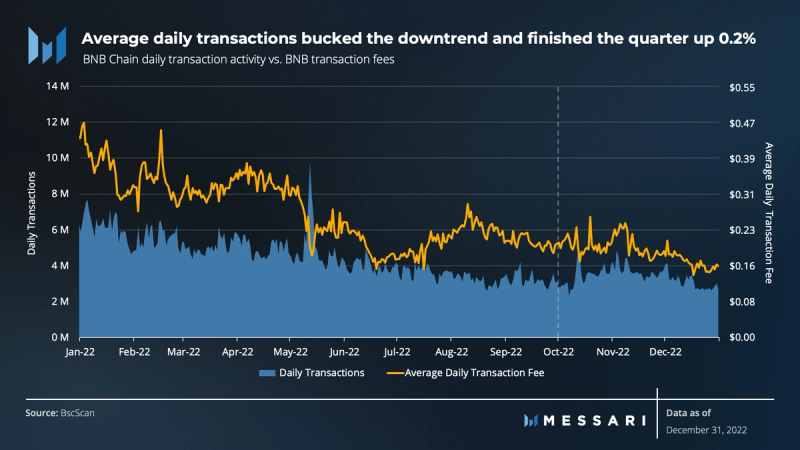
Average daily transaction activity on the network followed a similar pattern of daily active address activity: a downward trend followed by an inflection point at the end of Q3, suggesting foundational transaction activity was forming. That foundation remained steady as BNB Chain’s average daily transactions bucked the downward trend, finishing the quarter up slightly (0.2%).

BNB Chain’s revenue and network value continued to be correlated, as the volatility in daily revenue was generally accompanied by movements in network value. The revenue and network value trend followed the address and transaction activity pattern during Q4. Since user activity influenced revenue and network value and was driven by ecosystem expansion, changes in revenue and network value were supported more by fundamentals than speculation.
Fundamentals were in line with each other as revenue declined by 10.2% over the quarter, along with an 11.9% decline in average transaction fees. Network value dropped by a similar magnitude (-13.4%).
For perspective, in Q3, revenue and transaction fees were down, but network value was up. Fully diluted value (FDV) was 850 times the total quarterly revenue at the end of Q3.
In Q4, revenue and network value change was closely tied to network usage, and FDV was 820 times total revenue. The relationship between FDV and revenue suggests that BNB became fundamentally less expensive per unit of revenue than in the prior quarter.
Ultimately, it was a positive sign that the catalysts for user growth came on the heels of a foundational user base and a more favorable valuation for BNB Chain’s network, especially after the FTX drama unfolded during Q4.
Ecosystem and Development Overview

Fundamentals like user and transaction activity could generate more revenue and, therefore, network value. This value accrual would also be enhanced by the deflationary mechanism in BNB Chain’s case. The factors driving BNB chain’s fundamental activity include its developer engagement and growth strategy.
BNB Chain’s growth strategy has been at the core of recent activity across the various sectors of BNB Chain’s ecosystem.
Ecosystem Growth Strategy
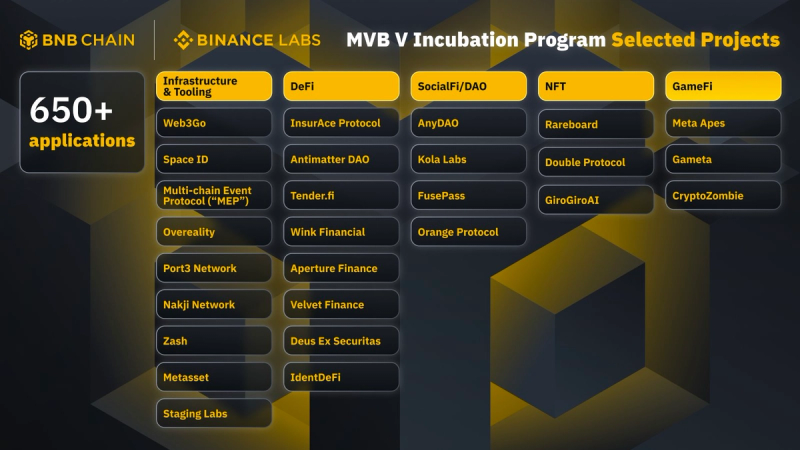
Source: bnbchain.org
At the end of Q2, BNB Chain announced the MVB V Accelerator Program (MVB V) to help projects develop working products. In Q3, 27 projects (listed above) out of more than 650 applicants were selected to join the accelerator program. Projects ranged from tooling and DeFi to NFT and GameFi.
All 27 projects receive mentorship and support from BNB Chain and the Binance Labs ecosystem. They gained access to general tech, product, tokenomics advisory, and community marketing support. Further, during Q4, 7 of the 27 projects were selected to receive financial support.
During Q4, BNB Chain also launched BNB Builder Grants. The grants were opened up to new projects aiming to build on or migrate to BNB Chain. Each month, up to 10 projects are selected through a rigorous assessment to receive financial grants, non-financial support, or both.
Further still, BNB Chain launched the European Innovation Incubator Program during the quarter. The incubator is a virtual program designed for startups across Europe. The incubator provides long-term support by offering resources and training.
BNB Chain also launched a $10 million Growth Incentive Program. The program went live in Q4, offering incentives every month of up to 800 BNB per project. Individual projects were also eligible to receive $1 million a month to cover fees spent on gas.
Finally, BNB Chain’s first Soulbound Token (SBT) in Q3 brought more activity to the ecosystem in Q4. The first SBT was the Binance Account-Based (BAB) token. Throughout Q4, exclusive benefits, many of which were in the GameFi space, continued to be rolled out to BAB token holders. These incentives drew users across the ecosystem, according to a community analysis of BAB’s effectiveness.
The execution of the above strategies is provided in more detail in the following sections.
DeFi
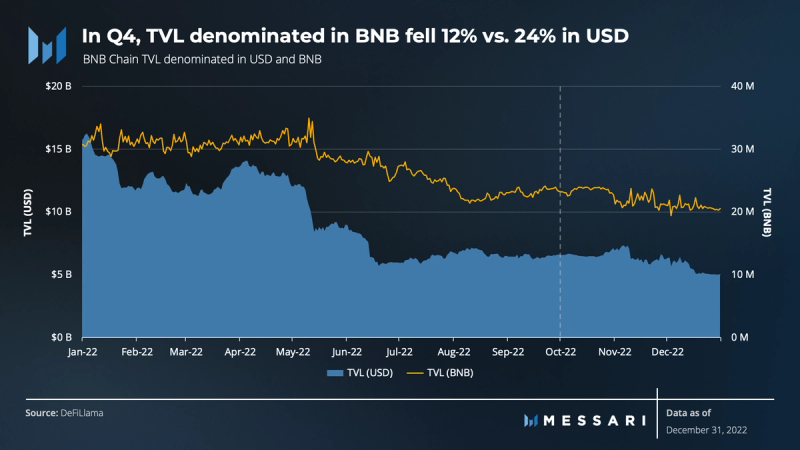
There is no doubt that early 2022 was the end of the last bull cycle and that a bear market was underway. As market sentiment shifted, TVL fell 23.6% in USD over Q4 and finished the year down 68.1%. Although TVL in USD was down, the drop in TVL denominated in BNB (-32.8%) was less drastic.
Liquid staking also played a role in supporting BNB Chain and its DeFi ecosystem. During Q3, BNB Chain implemented liquid staking with three prominent multichain platforms: Ankr, Stader, and pStake. By the end of Q4, these three platforms comprised 2% of TVL, roughly $78 million or 316,000 BNB.
While these protocols fill a growing demand for liquid staking, their presence also inflates the TVL represented in USD as they essentially equate to double-counting TVL.

None of the DeFi applications on BNB Chain were immune to the macro climate of 2022 or the FTX debacle in Q4. BNB Chain’s most prominent protocol, PancakeSwap, was down 27% QoQ in terms of TVL. At the same time, PancakeSwap’s dominance declined for the second consecutive quarter.
The shift in dominance can be seen as a positive indicator for BNB Chain. BNB Chain TVL has always been heavily concentrated in PancakeSwap, which holds roughly 42% of BNB Chain’s DeFi TVL. If the application were to collapse due to an exploit or technical breakdown, it could significantly hamper the BNB Chain ecosystem.
Rather than solely relying on one protocol, the BNB Chain community continues to implement strategies to grow and diversify TVL across DeFi, such as by introducing liquid staking. During Q3, liquid staking allowed TVL to flow into and bootstrap new protocols like Wombat Exchange, which subsequently grew by 7% during Q4.
Venus Protocol also stood against the bear, growing its TVL by 2% QoQ. The Binance exchange Launchpad and Launchpool drove interest, and its revenue increased by 246% QoQ. The Venus V4 upgrade emission reduction also helped lower sell pressure on its token.
The BNB Chain’s growth strategies highlighted above were also deployed to expand the DeFi sector.
Notable DeFi projects selected to receive support include:
MVB V Program
- Antimatter DAO – Derivatives and financial NFTs platform.
- Tender.fi – Undercollateralized lending and borrowing protocol.
- Aperture Finance – Cross-chain investment solution.
- Velvet Capital – A crypto index fund platform that was also one of seven projects selected to receive financial support through the program.
BNB Builder Grant
- Hummingbot – Open source market-making client enabling high-frequency crypto trading of BEP-20 assets.
European Innovation Incubator
- Wallchain – Integrates with DeFi platforms to enable users to capture MEV profits.
- Cashmere Labs – MEV-protected DEX aggregator and stableswap platform.
- Vyper Protocol – Primitive for permissionless derivative trading.
- Cora Protocol – Decentralized lending platform without liquidations.
Other notable developments in the BNB Chain DeFi space included:
- Zebec – Multichain continuous settlement protocol that migrated from Solana to BNB Chain.
- Thales – A positional markets protocol and platform that expanded to BNB Chain.
- Balancer & Fjord – Launched liquidity bootstrapping pools (LBPs).
NFTs
It was a breakout year for the BNB Chain NFT sector, growing secondary sales volume by 857.9% YoY. The initial success of the Element NFT Marketplace, the development of the NFT aggregator Rareboard, and strategic investments from the ecosystem growth fund all helped spark initial activity.
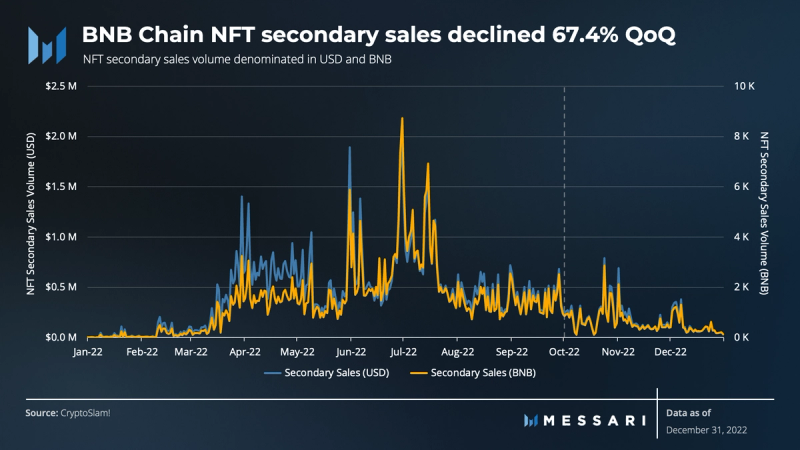
While BNB Chain emerged in the NFT space in Q2 2022, macro forces may have stalled sales volume during the back half of 2022. Total NFT secondary sales volume continued to decline, down 67.4% QoQ.
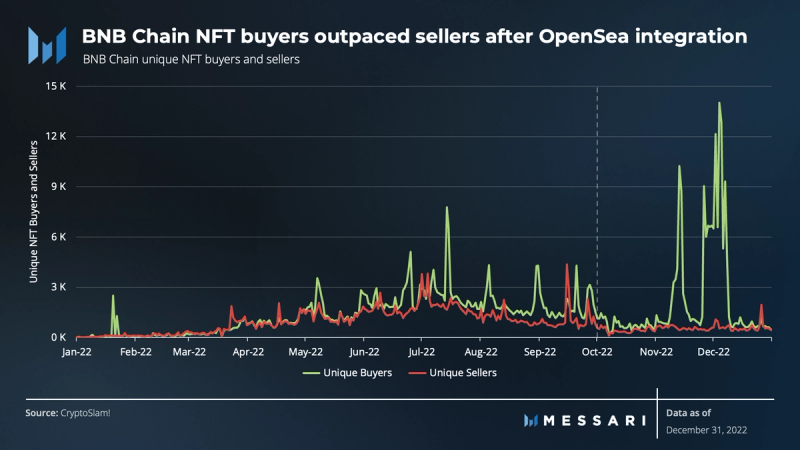
While sales volume continued a downtrend, unique buyers continued to outpace sellers. Buying activity spiked when BNB Chain NFTs were made available for listing and sale on OpenSea in December. Following the integration, BNB Chain and OpenSea held a promotional contest enabling users to win over $100,000 in NFTs from dozens of projects across the BNB Chain NFT and gaming space.
Beyond OpenSea, potential future growth of NFT activity on BNB Chain may also come from its growth strategy. Notable NFT projects selected to receive support include:
MVB V Program
- Double Protocol – NFT renting platform.
- GiroGiroAI – AI infrastructure for generating intelligent dynamic NFTs.
- Orange Protocol – Reputation and trust-minting protocol.
- Metasset – Community-based NFT affiliate network tooling.
- Rareboard – NFT marketplace aggregator.
Each of the above projects was selected to receive non-financial support through the program.
BNB Builder Grant
- Owl Protocol – Building open-source smart contract primitives, SDKs, APIs, and a no-code UI to enable new utilities for dynamic NFTs.
Another notable development in the BNB Chain NFT space included:
- REVO – Video NFT social networking service that migrated from Solana to BNB Chain.
GameFi
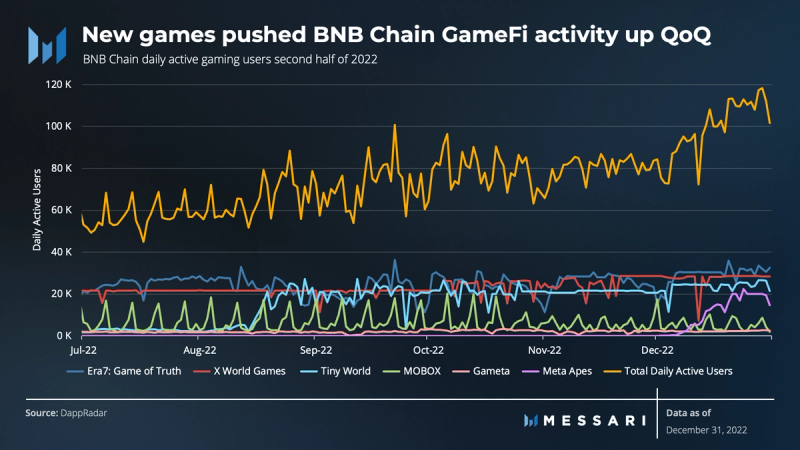
BNB Chain gaming finally gained traction in 2022. Recent applications like “Era7: Game of Truth,” “Tiny Worlds,” and “X World Games” had steady daily user activity QoQ. New games such as Meta Apes also entered the fray during Q4, and the number of daily active users in the GameFi ecosystem continued to trend upwards.
This upward trajectory was bolstered by the overall BNB Chain growth strategy. There were several notable GameFi projects selected to receive support:
MVB V Program
- Gameta – Gaming platform that offers nine casual games and has over 20 applications in development. Gameta was one of the seven projects selected to receive financial support through the program.
- Meta Apes – Free-to-play and win-to-earn mobile strategy game that is the first BNB Sidechain game. Meta Apes was also one of the seven projects selected to receive financial support through the program.
BNB Builder Grant
- Puffverse – A 3D dreamland metaverse that received a grant after rigorous assessment.
European Innovation Incubator
- RealFevr – Gaming ecosystem built around licensed sports digital collectibles.
- Mummy.io – Open-world multiplayer roleplaying game (RPG).
Other notable developments in the GameFi space included the launch of P12 Arcana (a gaming carnival) in partnership with Project Twelve (P12) and Quest3. P12 Arcana’s pre-launch in September uncovered significant demand before its official launch in October. P12 Arcana aimed to introduce Web2 gamers to BNB Chain’s Web3 gaming world. With the same goals in mind, BNB Chain formed a partnership with GameFi.org.
Unique Use Cases, Infrastructure, and Tooling
Outside of the DeFi, NFT, and GameFi sectors, noticeable network activity was sparked by the gamified SocialFi platform Hooked Protocol.
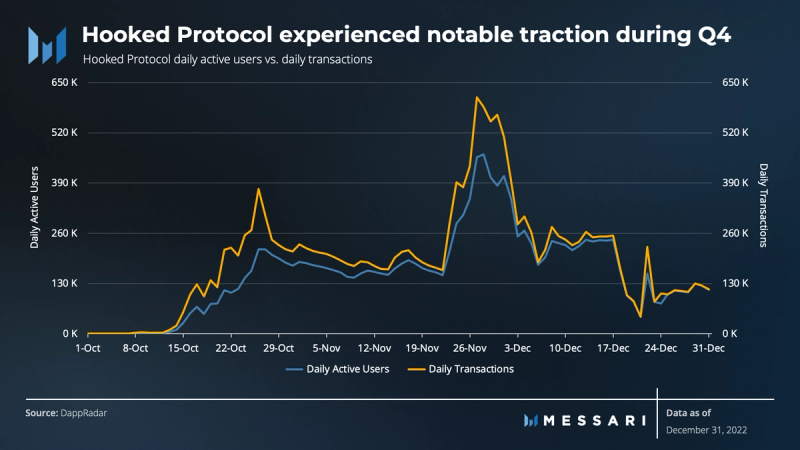
Hooked achieved over 50,000 daily active users on the first day of launch in October and reached over 600,000 users during Q4. The activity on Hooked generated the spike in active addresses and transactions highlighted earlier. Around the same time, the first application built on Hooked Protocol, Wild Cash, launched and ranked number one in gaming and second among all apps in Indonesia Google Play within its first week.
Beyond Hooked and its unique position in the BNB ecosystem, a slew of other unique use cases, infrastructure, and tooling emerged. BNB Chain’s deliberate growth strategy also bolstered several of these types of projects. It selected several unique projects to receive support, including:
MVB V Program
- Space ID – Censorship-resistant, naming service network.
- Overeality – Implementing scalable zero-knowledge proof systems for zkBridge and ZK-rollups.
- Multichain Event Protocol (MEP) – Interoperability communication protocol.
- Web3Go – Multichain open data analytics platform that indexes blockchain data.
Each of the above projects was the remaining four of seven that were selected to receive financial support through the program in Q4.
BNB Builder Grant
- Dmail – Web3 decentralized email service.
- XDAO – Tool for creating Decentralized Autonomous Organizations (DAOs).
- BlockVision – Multichain node, mempool, NFT, and DeFi API provider.
European Innovation Incubator
- Blockless – Developer solution that provides end-to-end solutions such as zkWASM and dynamic web hosting.
- AltLayer – System of several optimistic rollup-like execution layers.
In the end, the growth strategy will continue to push forward throughout 2023. Binance Labs and BNB Chain launched season six of the MVB Accelerator Program (MVB VI). Like the seasons before, MVB VI will aim to drive growth in infrastructure, middleware, DeFi, GameFi, SocialFi, and beyond.
Despite the market headwinds of 2022, especially in Q4, BNB Chain maintained an aggressive strategy to deploy financial and human capital across its ecosystem. The catalysts for growth and its position in DeFi, NFT, and GameFi will likely remain competitive.
Development Activity

Developer engagement, as measured by unique smart contract verifications, has yet to catch up to BNB Chain’s growth strategy. Smart contract verification is triggered by the developer to translate the code into a higher-level language. This measure followed a similar quarterly pattern to DeFi and NFT activity, down 28.5% QoQ.
In previous reports, core developer involvement was measured by data sources tracking the events in the BNB Chain’s GitHub repository. The data indicated that core development was insignificant over the last several quarters.
Staking and Decentralization Overview

Staking and decentralization of the network improved over an otherwise volatile year. The average engaged stake (voting power stake divided by total supply) on BNB Chain grew steadily, increasing by 31.1% over the last year.

Implementations to further decentralize and increase censorship resistance of the network began to unfold by the end of Q3 and continued into Q4. In Q3, BEP-131 introduced candidate validators onto BNB Smart Chain to improve the robustness of the network, and over 50 validators (active and in-active candidates) were plugged into the network by the end of Q4.
The active validator set also grew from 21 to 23 over Q3. In Q4, the community voted and passed a proposal to add three more active validator seats, expanding the active validator set to 26.
Further, in Q3, the Gibbs upgrade and BEP-153 were introduced. This release went live in Q4 and enabled staking support on the BNB Smart Chain via a new staking system contract. The Einstein upgrade was also introduced to implement BEP-159. This BEP introduced a permissionless validator election mechanism and brought the staking economy onto the Beacon Chain.
BEP-131, 153, and 159 will continue to facilitate the growth of the active and candidate validator set. This growth should enable more validating and staking participation, catalyzing greater distribution of stake.
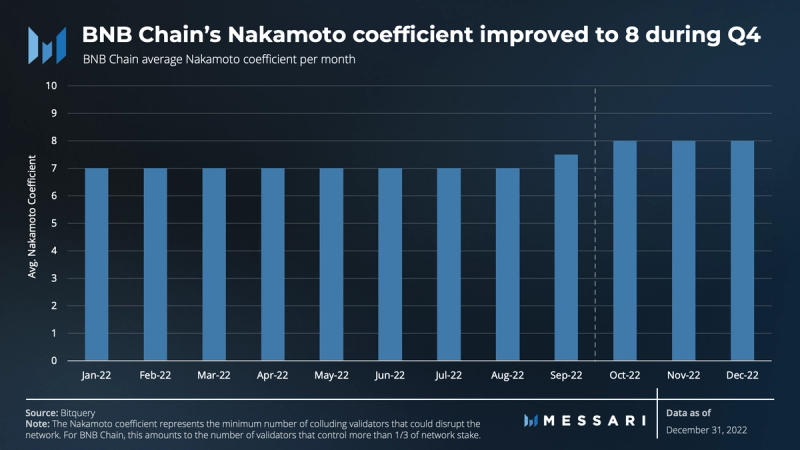
BNB Chain’s average Nakamoto coefficient stayed at 7 over the last year before increasing to 8 in Q4. Contrary to the prevailing belief, none of the network’s validators are run by the Binance exchange. Eight validators, including those run by independent third parties such as HashQuark and Certik, contribute to just under ~33% of the network’s total stake.
Despite the criticisms about the small validator set, BNB Chain is not an outlier concerning decentralization. Its Nakamoto coefficient of 8 is within the industry median. Nonetheless, BNB Chain should continue to improve its decentralization as it implements the security and network reliability upgrades highlighted above.
Competitive Analysis
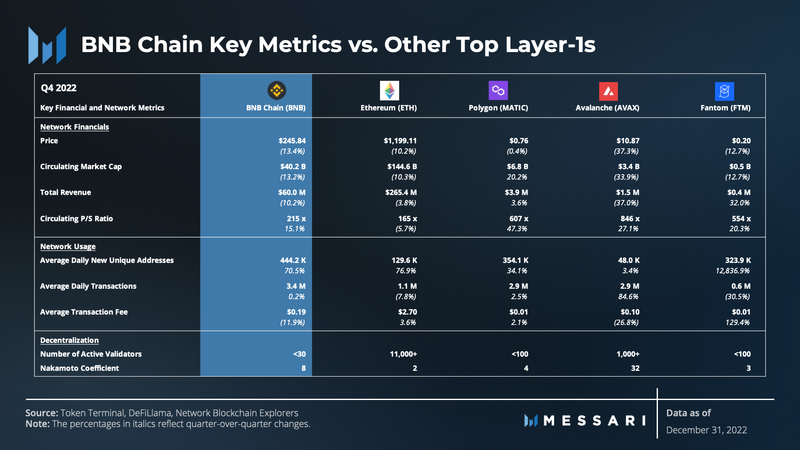
Throughout Q4, BNB Chain’s key metrics behaved similarly to other top Layer-1s. This peer group was derived by simply grouping the chains with the largest number of DeFi protocols and TVL. While nuances may prevent a perfect apples-to-apples comparison, it is possible to see see how each chain performs directionally.

BNB Chain’s valuation dropped at the onset of FTX’s undoing and finished the quarter down 13.2%. The peer group was also impacted and declined by a similar magnitude. Polygon was the least affected and finished the quarter up 20.2%.
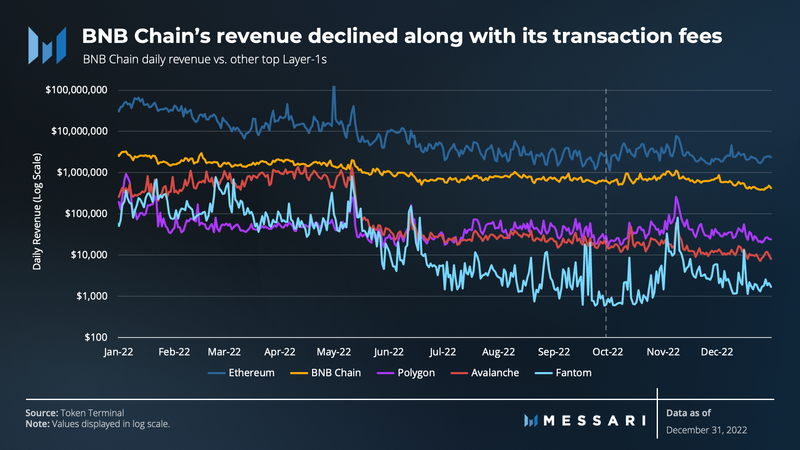
With the decrease in average transaction fees, BNB Chain’s daily revenue trended downward. The peer group experienced various trends as user activity varied across each. Polygon and Fantom were outliers that generated greater revenue QoQ.
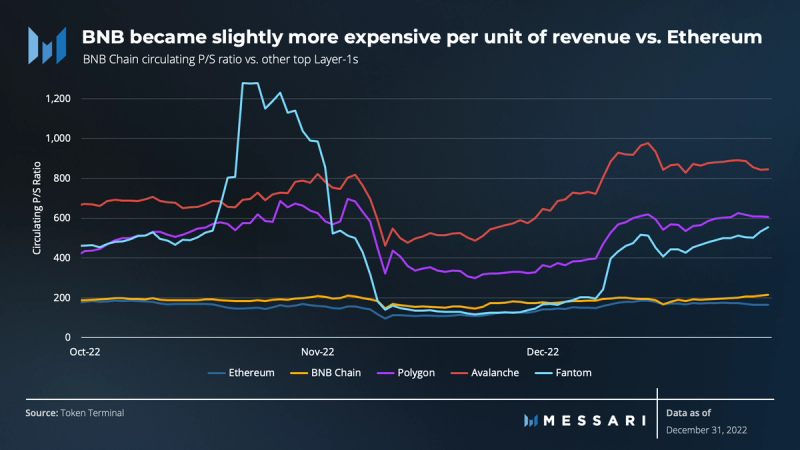
Over the quarter, BNB Chain’s P/S ratio increased slower than most of the peer group. Looking at the change in P/S helps gauge a protocol’s revenue and gives a sense of the number and cost of transactions processed. Because BNB Chain’s value increased and its transaction activity put downward pressure on revenue, BNB became slightly more expensive per unit of revenue compared to Ethereum.
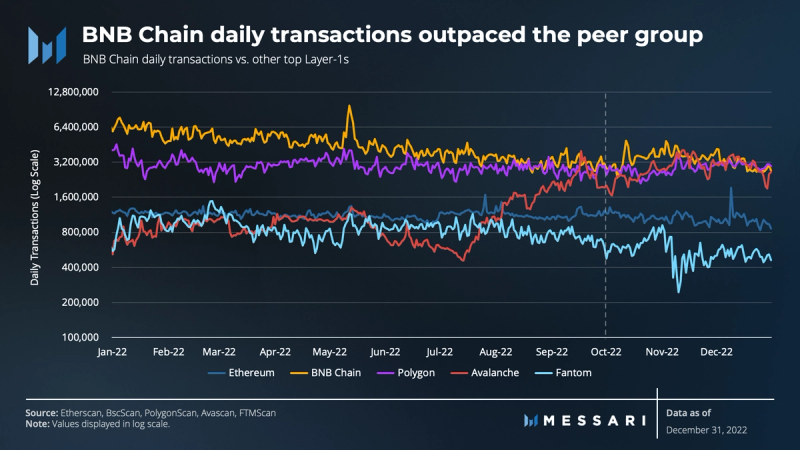
Daily transaction activity was flat over the quarter. BNB Chain finished the quarter with a foundational level of daily transactions similar to Polygon. On average, Polygon processed ~2.0 million transactions per day, and BNB Chain averaged ~3.4 million per day over the quarter.
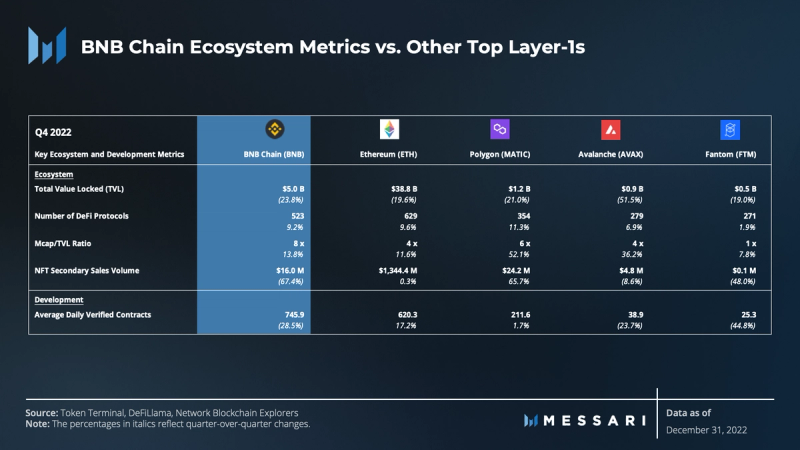

BNB Chain’s TVL declined (23.8%) by a similar magnitude compared to the peer group. Avalanche experienced the most significant drop and finished the quarter down 51.5%. Because TVL is often evaluated in USD, the native asset’s decline in value represents the shift in TVL versus the actual utilization of the native assets. While BNB Chain TVL in USD was down 23.8%, the amount locked denominated in BNB only declined by 11.8%.
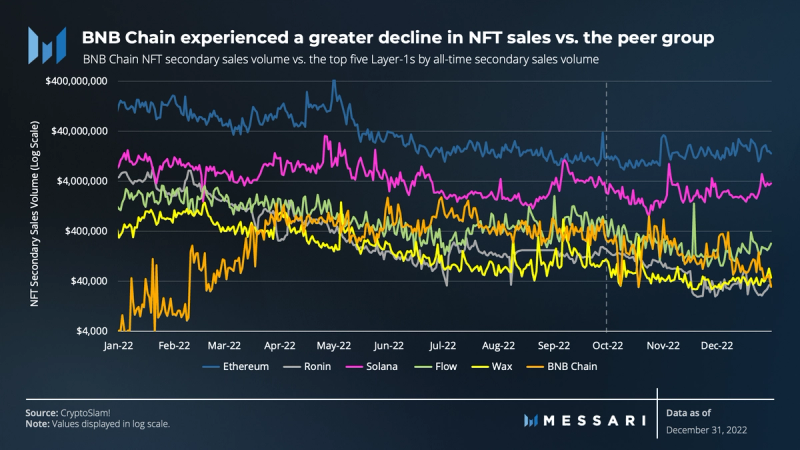
It was a breakout year for the BNB Chain NFT sector. While BNB Chain broke into the NFT marketplace, macro forces may have stalled sales volume as it declined (-67.4%) more drastically than the peer group QoQ. With that said, BNB Chain continued to deploy financial and human capital across its NFT ecosystem, seeking to remain competitive in 2023.
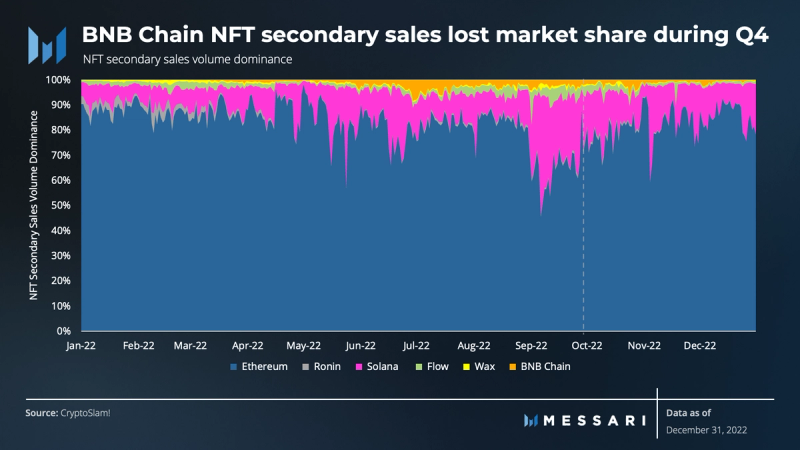
Though Ethereum still dominates roughly 80% of the secondary NFT market, BNB Chain remains in the top 10 by all-time secondary NFT sales volume.
Qualitative Analysis
Key Events, Catalysts, and Strategies for Ecosystem Growth
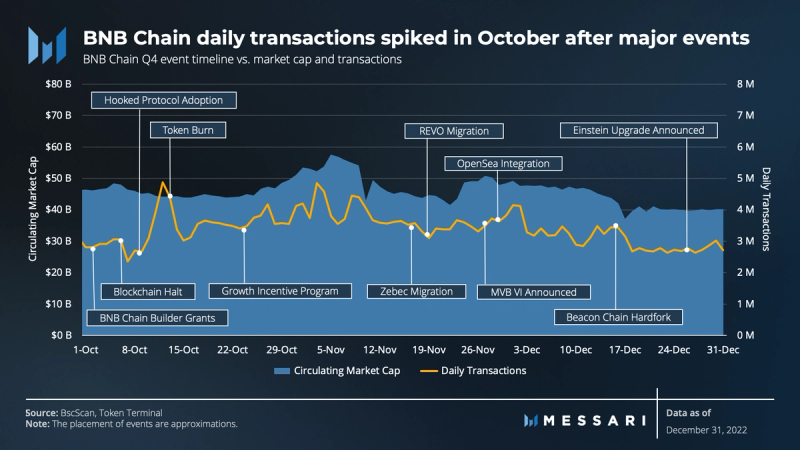
While the bear market continued and the FTX catastrophe sent many users into a panic, BNB Chain carried on with its expansion strategies and upgrades throughout Q4. As highlighted earlier in this report, network upgrades continued to improve BNB Chain’s robustness and functionality, while further decentralizing the network. With BNB Chain’s aggressive growth strategy, more DeFi protocols were rolled out, and the NFT landscape continued to emerge with integrations, notably with OpenSea. GameFi and unique use cases continued to catalyze a new wave of activity.
Aside from these ecosystem developments, other aspects of BNB’s strategy have been running in the background throughout 2022. Two of these strategic elements stood out during Q4 in particular:
- Technical Developments — Evolve network architecture and improve functionality.
- Community — Acquire developers and drive adoption through community building.
Technical Developments
During 2022, BNB Chain announced a technological roadmap with significant updates deployed on mainnet. Beyond furthering decentralization, other updates were aimed at faster transactions, extra capacity, sidechain development, and ZK-rollup technology. A number of those initiatives were pushed forward through Q4.
The team continued to make progress on zkBNB. zkBNB is a trustless scaling solution for BNB Smart Chain built on ZK-rollup architecture. With zkBNB, all funds are held on the BNB Smart Chain, while computation and storage are performed on a Layer-2 with less cost and more speed.
In Q4, the team launched the first zkBNB testnet and shared its following features:
- Built-in AMM and NFT marketplace.
- Sharing the same cryptographic security as BNB Smart Chain due to using zk-SNARK proofs.
- Allowing BEP-20 or BNB as a gas token.
- Uninterrupted L1-L2 communication, allowing users to withdraw funds at any time.
The team aims to release zkBNB Mainnet in Q1 of 2023.
Additional releases on the Beacon Chain also rolled out. The BNB Beacon Chain fork enabled text proposals on BNB Smart Chain (BEP-173). BEP-173 introduces a new method for coordinating strategy, plans, commitments, future upgrades, or other statements. Text proposals are exclusively a signaling mechanism and focal point for future coordination, i.e., they do not directly cause changes on-chain.
BNB Chain made progress on its long-term goal of running parallel EVM execution. Parallel EVM execution aims to significantly improve the performance of block processes by executing transactions concurrently. In October, NodeReal delivered a feature release: Parallel EVM 2.0. As part of this release, the testing and analysis of results were shared with the BNB Chain community, showing evidence of significant efficiency gains.
Finally, the BNB Chain expanded its utilization of oracles. In early Q4, BNB Chain entered into a partnership with Pyth network. The engagement will enable high-quality real-time market data for crypto feeds. Further, Binance Exchange launched Binance Oracle, a data feed network that connects real-world data to blockchain smart contracts. Binance Oracle will enable smart contracts to run on real-world inputs and outputs, starting with the BNB Chain ecosystem.
Community
Alongside the impressive technical innovation and ecosystem growth efforts over the quarter, BNB Chain’s community-building efforts also noticeably ramped up at the end of the year.
BNB Chain negotiated discounts and premium services with critical development tools and grouped them into a starter pack called BNB Chain Kickstart. BNB Chain Kickstart provides essential tools and services to help developers and projects build and grow their applications on BNB Chain.
The network also launched a developer education initiative with the Turkey-based education platform Patika. The nine-month program provides guided support through self-paced, cohort-based learning. It features a curriculum with Solidity fundamentals and program development on BNB Chain. A partnership with Smart Contract Developers Turkey (a developer community in Turkey) was also formed to expand the BNB community in that region.
Finally, BNB Chain regularly hosted BNB Chain Innovation Pitch Day across the U.S. The pitch days connected BNB Chain’s investment arm and top VC partners with projects. The pitch day events appeared to ramp up heading into 2023.
Ecosystem Challenges
Despite the progress BNB Chain made towards its long-term goals, Q4 did present an adverse outcome stemming from technical challenges.
In early October, Binance Smart Chain was halted by node operators due to “irregular activity” on the network. Before the halt, security researchers at PeckShield indicated that 2 million BNB were claimed from the Binance Smart Chain Token Hub.
Shortly after, the BNB Chain team confirmed that Binance Smart Chain was suspended. They later confirmed that an exploit affected the native cross-chain bridge between BNB Beacon Chain and BNB Smart Chain, known as “BSC Token Hub.”
Several upgrades were released following the October 6 exploit:
- Oct. 7, 2022 – Released V1.1.15 of the BSC client as a hotfix and hard-fork release that blocked several addresses due to the hack.
- Oct. 11, 2022 – Released V1.1.16 of the BSC client that contained a temporary urgent patch to mitigate the cross-chain infrastructure between Beacon Chain and Smart Chain. Changes in this release included fixing the vulnerability.
- Oct. 28, 2022 – BEP-171 was proposed to introduce several security enhancements for the cross-chain bridge between BNB Beacon Chain and BNB Smart Chain.
In summary, the exploit occurred on the cross-chain bridge (BSC Token Hub) and resulted in extra minting of BNB.
A total of 2 million BNB (nearly $570 million at the time) was effectively minted and taken by the hacker. Through off-chain coordination, global BSC validators volunteered to upgrade so that they could prevent most of the stolen funds from leaving the exploiter’s address. Once the dust settled, about $100 million remained unrecovered and moved off-chain by the hacker, and no users or users’ funds were affected.
Despite this unfortunate challenge, the issue was isolated and unique. Moreover, the core BNB Chain protocol and its cryptography were not compromised.
The Road Ahead
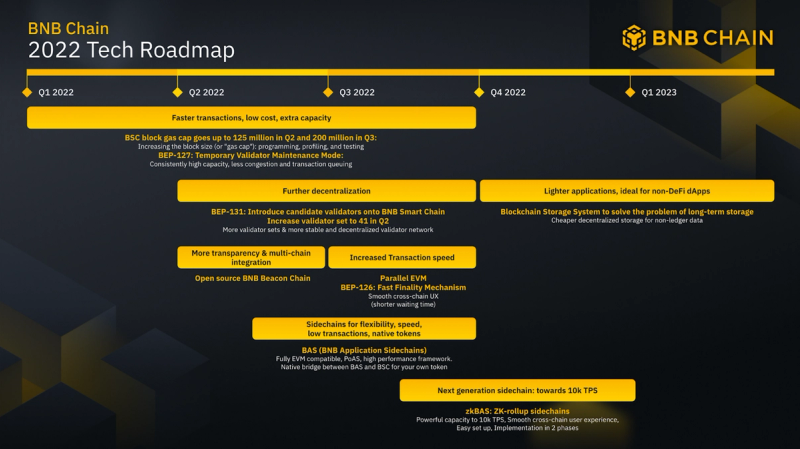
Source: bnbchain.org
BNB Chain was largely successful in executing its 2022 roadmap. Looking ahead, the approach to success will continue to include the following characteristics:
- Executing growth strategies and implementing technical developments such as scaling solutions.
- Boosting throughput.
- Expanding the validator set.
As is the case across the crypto sphere, implementing ZK technology may be the most significant challenge for BNB Chain and its plans for BNB ZkRollup. For now, the BNB Chain community plans to expand the network with L2-like solutions. These include the launch of ZK-rollups for high-performance scaling and sidechains for more customizable blockchain solutions. The team aims to release zkBNB Mainnet in Q1 of 2023.
BNB Chain continues to take intentional steps toward greater decentralization. The team open-sourced the validator set of the Beacon Chain and has been evaluating different approaches to both the election period and the elected validators of the BNB Smart Chain.
BNB Chain plans to implement a blockchain storage system in the near term, with the goal of solving the problem of long-term data storage. It will do this with a decentralized network of Storage Providers (SPs) that will enable users to request data storage to store their data off-chain. The system may also spark a new data economy by allowing users and applications to create, store, and exchange data with ownership.
The implementation of parallel EVM execution is also on the horizon. Parallel EVM implementation will be accomplished in several phases as part of a long-term initiative.
Finally, during Q4, BEP-176 was drafted to introduce a new validator reward model on BNB Smart Chain. As a result of this BEP, the validator staking reward policy will be modified to more accurately represent the validator’s contribution to the overall network. There should be more developments around this proposal in 2023.
Closing Summary
2022 was a tumultuous year for the crypto industry. The year started with a bear market in January, followed by the collapse of LUNA and UST in the spring, and the failure of FTX in the fourth quarter. Despite the market volatility, BNB Chain lived up to its Build N’ Build name with network upgrades and ecosystem expansion that showed considerable strength through Q4.
BNB Chain executed a growth strategy that facilitated significant strides toward adoption. It made several upgrades to core functionality, integrated with strategic partners, and expanded into DeFi, NFTs, GameFi, and beyond.
On the network side, daily active addresses were on the rise, and average daily transactions remained steady at ~3.4 million per day. Increased stake amounts and a growing validator set, signal that the network is progressing toward a more decentralized state.
The DeFi sector on BNB Chain saw TVL drop 23.6% in USD terms over Q4 due to the FTX debacle. Despite this, the NFT sector continued to progress, forming partnerships with OpenSea and other projects to catalyze demand. GameFi continues to grow thanks to BNB Chain’s growth initiatives and collaboration with dozens of projects.
Despite several challenges along the way, BNB Chain successfully executed its 2022 roadmap. It will continue to focus on growth strategies and technical developments such as scaling solutions and boosting throughput. The team plans to expand the network with L2-like solutions, such as ZK-rollups and sidechains, and to increase decentralization by open-sourcing the validator set. BNB Chain plans to implement parallel EVM execution in several phases, already drafting a new validator reward model to be implemented in 2023.
After a dramatic year with many challenges, BNB Chain looks to remain competitive heading into 2023.





















